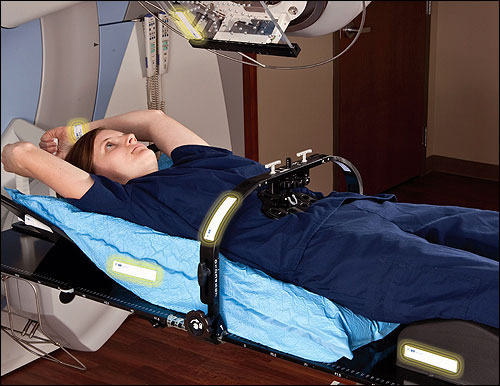When oncology patients visit radiation therapy clinics, they typically schedule a series of short visits extending for weeks at a time (the average patient receiving external beam radiation therapy attends 29 treatments). As such, moving these patients efficiently from a facility’s waiting room to the machines that accomplish the therapy is imperative to effective clinic management. Efficiency not only eases patient discomfort, it also ensures the maximum usage of the radiation machines. Clinics can treat a hundred or more patients daily, and in addition to requiring efficiency, those facilities must also ensure that the proper equipment is utilized with each patient, in order to properly immobilize the correct body part prior to radiation. Using the wrong equipment could result in the therapy not being carried out correctly. According to a Joint Commission study, published in the commission’s Journal on Quality and Patient Safety, one in 500 radiation treatments experience an error.
CIVCO Medical Solutions, an Iowa-based medical division of Roper Industries, has designed the RFSuite RFID tracking and verification system to address the needs of oncology clinics. The solution employs EPC Gen 2 ultrahigh-frequency (UHF) passive RFID tags to track the movements of patients and staff members into and out of waiting and examination rooms, as well as through therapy, to ensure that no one waits excessively. What’s more, says Geoffrey Dalbow, CIVCO’s chief technology officer, the system is designed to ensure that the proper equipment is used on each patient; if a mistake is about to be made, an alert is issued to the medical staff before the radiation therapy begins.

At oncology clinics, patients typically undergo a consultation, followed by radiation simulation, at which time the proper equipment is identified to fit the body part in which that patient’s tumor is located, and to properly angle and immobilize the body so that radiation will be directed to that tumor. The equipment selected for that patient is of a specific size and type, and must be used when he or she undergoes treatment.
Approximately two years ago, the UC San Diego Moores Cancer Center began seeking an automated solution to track patients, equipment and employees. To that end, the hospital began working with CIVCO—which, according to Todd Pawlicki, the director of medical physics and clinical operations at the radiation oncology department of the University of California, San Diego (UCSD), was the only company offering such a solution.
CIVCO installed a system to track the locations of tagged individuals and equipment throughout the clinic’s two buildings. The facility treats about 100 patients daily, using one internal and four external radiation machines. In approximately three months, Pawlicki expects the number of patients treated per day to grow by 30 percent to 50 percent. The use of RFID, he predicts, will assist the transition into that greater patient volume. “Not only will it be important to help us manage our growth,” he says, “but once we identify workflow procedures, it will help us maintain efficiency.”The CIVCO system deployed at the Moores Cancer Center includes readers in both buildings, including some manufactured by Impinj and ThingMagic, that provide 100 percent coverage of the area, as well as EPC Gen 2 passive RFID tags for equipment, and RFID cards for staff members and patients (CICVO also offers RFID-enabled wristbands for patients). The system went live in the fall of 2010, Pawlicki says, and the results are still being analyzed.
Upon arriving at the Moores Cancer Center, a new patient is assigned a plastic card containing an RFID tag encoded with a unique ID number linked to his or her identity in RFSuite software residing on a CIVCO-hosted server. The card is also printed with a unique bar-coded ID number linked to that patient’s name in the clinic’s radiation machine operating software. When returning for subsequent visits, the patient presents his or her card to a device at the entrance that contains both a bar-code scanner and an RFID reader. In this way, both systems are updated to indicate that the individual has arrived. The RFSuite software lists the names of all patients located onsite, along with their status (such as in a waiting room or a changing room), and illuminates in red the names of those who have been waiting beyond a specified acceptable length of time.
In addition, staff members wear RFID-enabled cards on lanyards, with the intention of using the captured data to update the system to indicate when a health-care practitioner sees each patient. To date, Pawlicki notes, that information is not being used, as the clinic continues to adjust to the new system.
The solution also includes an RFID tag attached to each piece of equipment that will be utilized with a particular patient. If the RFSuite software determines that the incorrect equipment is being employed, it flashes an alert on a PC located in the treatment room. The equipment tags also help employees locate equipment. “We have two buildings,” Pawlicki states, “so being able to locate a devices is a great tool.”
The RFSuite software tracks how long a patient has remained in one location, and issues alerts to specific staff members assigned to that individual—first to indicate the patient’s arrival at the entrance and the length of time spent in the waiting room, and then when a wait time has exceeded a specified acceptable length, such as 15 minutes.Once the patient has undergone radiation simulation, the equipment selected for use with that patient is tagged with RFID tags, each item with its own unique ID number that is then linked to the patient’s ID.
Once that has occurred, each time that a patient enters the radiation therapy room with his or her ID card, and tagged equipment is brought into that room, the CIVCO software captures the ID numbers of all tags, determines whether there is a proper match, and illuminates approval or rejection via a computer screen located within the treatment room. The screen also displays a photograph of the patient, helping staff members to ensure that the correct patient is treated at all times.
According to Pawlicki, the staff is still learning how to use the CIVCO system. “I think it’s been a bit of an adoption hurdle to get over,” he says, noting that since the clinic is one of the first to adopt the technology, it has very few models to which it can refer. “What we’re working on is introducing the system to patients and staff. We will see ways in which we can further use the data—but until now, we’ve been very much in the introduction and define phase.”
Other facilities also installing the system include the radiotherapy department of the Scientific Institute San Raffaele, located in Milan, Italy.


